|
July 1946 Radio-Craft
 [Table of Contents] [Table of Contents]
Wax nostalgic about and learn from the history of early electronics.
See articles from Radio-Craft,
published 1929 - 1953. All copyrights are hereby acknowledged.
|
A year after the two atom bombs
were dropped to end World War II, the newly formed Atomic Energy Commission
conducted detailed detonation tests at the
Bikini Atoll, in the
South Pacific. Most people more than 40 years old are very familiar with the
images of the giant mushroom cloud that formed over the site. This "Radio in the
Atom Tests" article from the July 1946 issue of Radio-Craft magazine
reports on plans being made to measure and record sound pressure, nuclear
radiation, radio and radar signatures, temperature, light spectrum and
intensity, and other parameters. The information would be used for improved bomb
making, nuclear power generation, medical imaging and treatment, and general
research on nuclear fission and fusion (a fission implosion is to initiate a
fusion reaction).
Radio in the Atom Tests
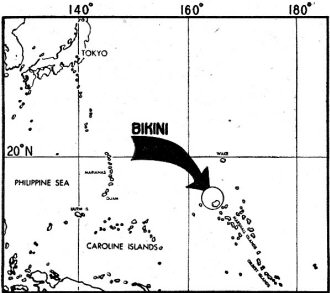
Fig. 1 - Bikini was selected for its remoteness from land areas.
By E. A. Witten
Electronic Specialists Will Learn Much at
Bikini Atoll
Probably the most elaborate scientific tests ever carried out as far as the number
of people, amount of equipment and total expense are concerned will be the atomic
energy tests this summer. For the gigantic task of measuring and determining the
amount of damage an atomic bomb can do, Joint Army-Navy Task Force One will send
three elaborately equipped laboratory ships to Bikini Atoll (Fig. 1). These ships
will carry many of the nation's top-ranking scientists with all equipment and instruments
necessary for conducting the tests. One ship will be devoted entirely to electronics
and will carry such equipment as radar units of the most advanced design, Geiger
counters, radiology equipment, long-range television apparatus, seismographs; all
in addition to the standard radio transmitting and receiving apparatus.
The technical staff will consist of over 1000 technicians. These men will be
divided up into nine specialist groups or divisions: bomb operation; blast pressure
and shock; wave motion and oceanography; electromagnetic propagation and electronics;
radiological safety; radiometry; radiation; remote measurements; and technical photography.
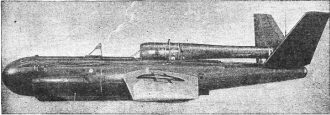
Photo A - The Kadydid, radio-controlled drone. Length, 11 ft.:
span, 12 ft.; speed, 200 m.p.h.
In the field of wave motion, supersonic echo sounders will measure the vertical
motion of both the target ships and the buoys at a distance from the explosion,
while pressure recorders on the bottom will record water depth versus time by measurement
of hydraulic pressure. In addition, seismographs will be set up on the islands around
the atoll to observe the propagation of shock waves through the earth and thus obtain
information on the geological structure of the atoll.
The electromagnetic propagation and electronics division will make studies of
the effect of the atomic bomb explosion on the propagation of electromagnetic waves.
These tests are planned to show the influence of the intense local ionization resulting
from the detonation on both sky and ground wave transmission. Other experiments
will show the radar reflective properties of the bomb cloud and the intensity of
the atmospheric electrical disturbances developed by the explosion.
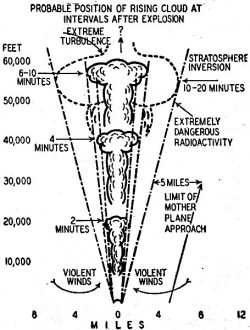
Fig. 2 - How the atomic blast is expected to develop.
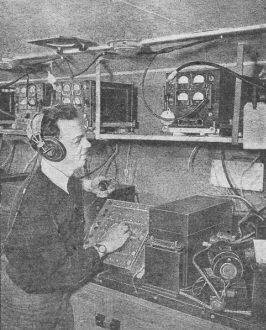
Photo B - The radio control room for launching and landing drones.
Standard Navy, Signal Corps, and Air Force radar equipment as well as special
devices constructed for the tests will be used to measure electromagnetic propagation.
The area to be tested, the distance covered by the blast, and a time base are shown
on the diagrammatical chart in Fig. 2.
Army Air Force "drones" will carry Geiger counter warning circuits and special
transmitters to determine the effect of the bomb explosion in the 5-to-9-megacycle
region. It is not known at present what effect the bomb cloud will have in radio
or radar interference or reflection.
The radiological safety section is charged with protection of personnel from
radiological hazards after the blast. This includes responsibility for measurement
of radiological phenomena in the areas to be entered by various personnel and for
tracking the movement of radioactive air and water masses caused by the explosion.
The primary safety device is the Geiger counter which indicates radioactivity by
a clicking sound, a cathode-ray tube or the movement of a hand on a dial. Additional
safety devices are ionization chambers, specially sensitized films, and chemical
capsules which indicate total radioactivity from the measurement of induced radioactivity.
Radiometry is the subject of study of another staff section. Radiometry is defined
for the purposes of the atom bomb tests, as a measurement of light in the visible
spectrum and adjacent wave bands (ultra-violet and infra-red). This is distinguished
from the staff section which is concerned with radiation or the measurements of
gamma rays, neutrons, etc.
Among the instruments used by this section are: spectrographs to obtain the spectral
distribution of the first flash; photo-electrical units to record the intensity
of the first flash as a function of time; and bolometers to measure the total radiant
energy emitted by the first flash. Unfortunately, the findings in this field only,
the instruments used and the techniques employed are classified under the security
regulations of the Manhattan Engineer District and will not be released for publication
till some time after the tests are completed.
Four Army Air Force's B-29's will be prepared to track and photograph the cloud
resulting from the blast to determine its persistency and radiological activity.
Ground photographs will be made from fixed installations on 75-foot steel towers,
placed at strategic points on Bikini Atoll. All these cameras will be radio controlled.
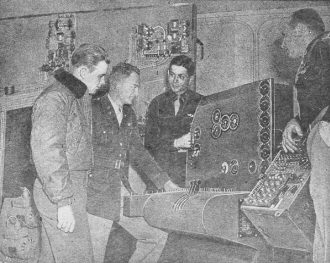
Photo C - AAF pilots preparing for the tests take refresher in
electricity and electronics.
Radio and television-equipped aircraft will play an important part in the tests.
Radio-controlled drones (Photo A) carrying radiological instruments will be directed
to the scene of the blast and information will either be radioed back to the observation
ships or the drones will be directed back to the ships. A new type of long-range,
high-altitude, high definition television system (See Radio-Craft, May 1946) installed
in the nose and waist of reconnaissance planes equipped with transmitting apparatus
will enable Task Force One officers to view at close hand the destruction and effects
of the bomb, which would otherwise be impossible, (or at least highly impractical
in terms of lives.)
The drones are scheduled to fly close enough to the atomic bomb blast so that
sensitive scientific and photographic instruments stowed in their cockpits will
record what happens when an atom bomb explodes on its target. Each of these drones
is controlled by a plane from which a Navy pilot will maneuver his drone, keeping
it always in sight and able to identify it by its colored tail. The drones are red,
overall, with a colored fin and rudder matching a color painted on the engine cowling
of the Queen Bee plane which controls its flight.
The drones will take off under the control of a Navy radio specialist in a radio
control truck (photo B) parked on the carrier flight deck. When they are 100 feet
in the air, the Queen Bee pilot takes over from the truck. After the explosion,
the Queen Bee planes and those drones that come through the tests will fly to
Roi
Island where they will be landed and the data which was recorded by their sensitive
instruments removed for study by the atomic scientists.
All AAF men participating in the tests are required to take refresher courses
in subjects pertinent to their specialty. Radio operators and technicians will be
schooled in the intricacies of radar and loran, both of which will be used in the
tests. (Photo C)
Posted October 22, 2021
|














